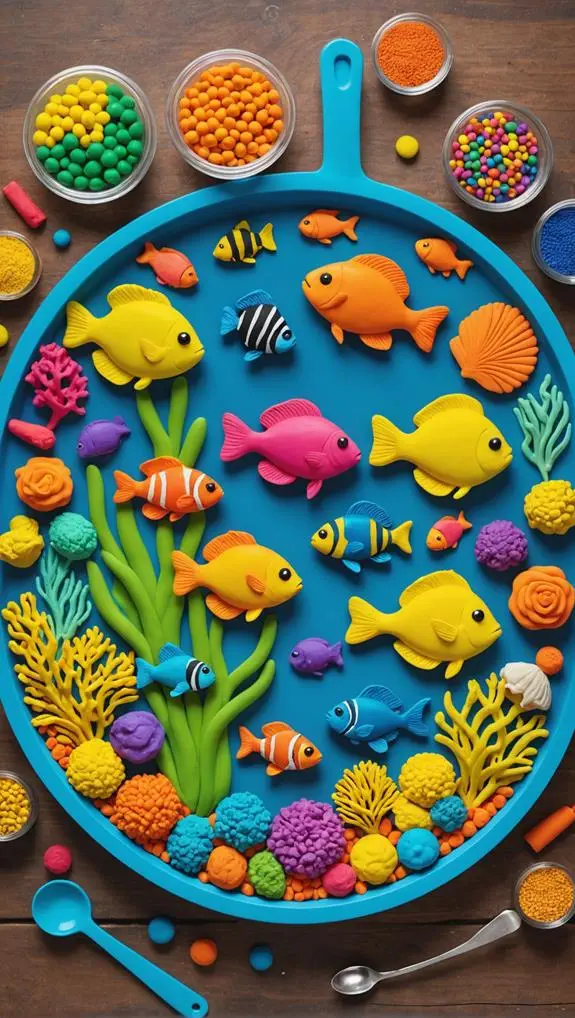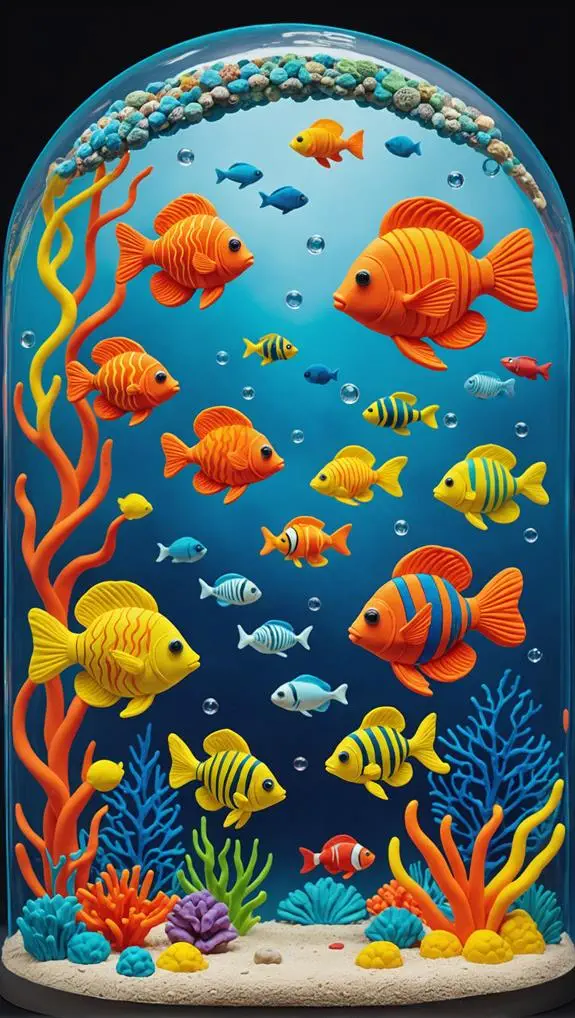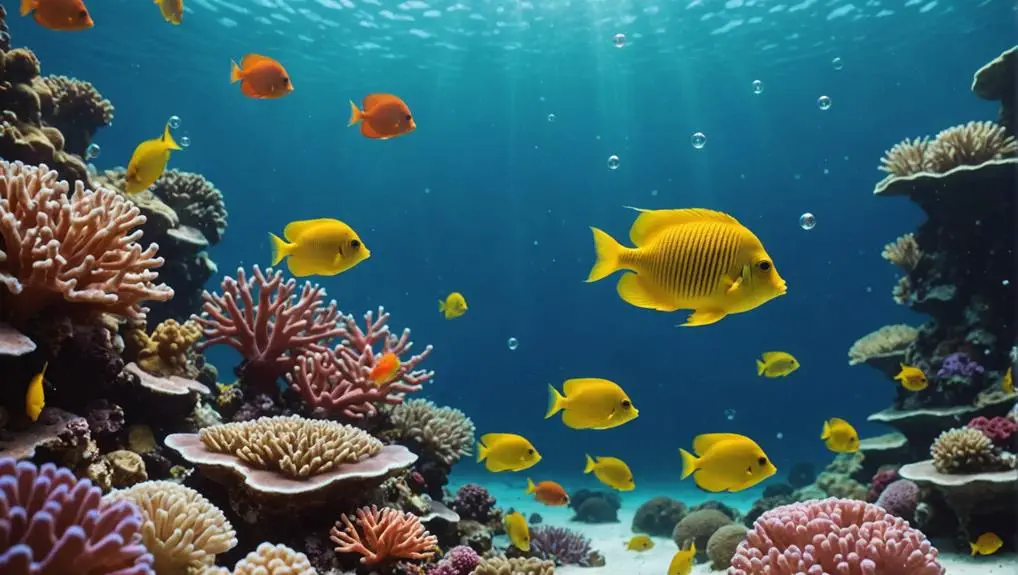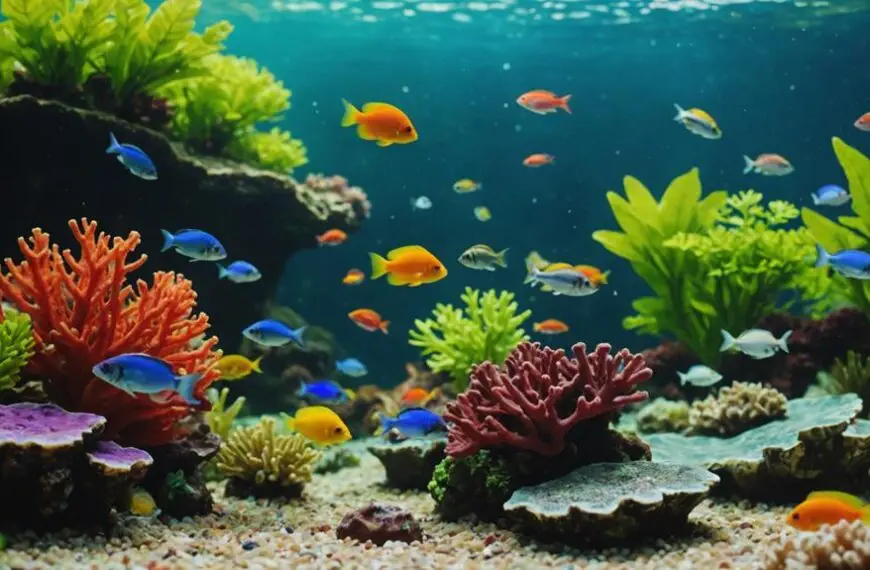The ideal feeding schedule for tropical fish depends on their dietary needs. Generally, feeding them once or twice daily is best, offering small amounts that can be consumed in about 2 to 5 minutes. For juvenile fish, aim for 2 to 5 meals a day to support their rapid growth. Don't forget to include fasting days—yes, even fish appreciate a good food break! Always keep an eye on their behavior; excited fish are hungry, while the uninterested ones might need your attention. Stick around, and you'll discover more tips to keep your aquatic buddies happy and healthy!
Contents
Understanding Fish Diet Types
Understanding the different diet types of tropical fish is crucial for their health and well-being. You'll find that tropical fish can be herbivorous, carnivorous, or omnivorous, and each type requires a unique balance of nutrients in their food.
Recommended hardy species like Guppies and Neon Tetras often thrive on varied diets, which can enhance their growth and vibrancy. Herbivorous fish love munching on plant materials and thrive on small quantities of food offered more frequently. In contrast, carnivorous fish prefer protein-rich meals and can get by with less frequent feedings—think of them as the occasional diners of the fish world!
Omnivorous fish, on the other hand, enjoy a mix of both meat and plant sources. This varied diet not only caters to their taste buds but also boosts their health and vibrancy. When you're choosing food, remember the size matters! The food should match the fish's mouth size to minimize waste and ensure they're getting the quality foods they need.
Offering a variety of food types, like flakes, pellets, frozen, and even live options, can make a huge difference in meeting the dietary needs of your fish. With the right fish diet, you'll help your aquatic friends thrive!
Recommended Feeding Frequency
When it comes to feeding your tropical fish, the frequency can really make a difference in their health and happiness.
Most adult fish thrive on one or two meals a day, while those little fry need a bit more attention, munching away several times daily to fuel their growth.
Don't forget to sprinkle in a fasting day or two each week—think of it as a little fishy detox to help keep them in tip-top shape!
Daily Feeding Practices
Feeding your tropical fish can be both a rewarding and critical part of their care. To keep your aquatic friends happy and healthy, aim to feed them once or twice a day. The key is to provide just the right amount of food—enough for them to devour in about 2-5 minutes. You don't want to see those sunken bellies that signal they're still hungry, nor do you want uneaten food floating around, which can mess with your water quality.
If you've got juvenile fish or growing fry, consider bumping up their feeding schedule to 2-5 times a day. They need that extra energy for all that rapid growth! Keep an eye on them during their meals. If they're eagerly munching away or there's leftover food, it might be time to adjust your daily feeding practices.
Also, remember that some fish have special requirements. For instance, nocturnal species prefer a midnight snack after the lights go out. Adapting your feeding schedule to their needs can make all the difference in their well-being.
Fasting Importance
Fasting your tropical fish once or twice a week plays a vital role in their overall health and digestion. It helps fish clear their digestive systems, promoting healthier gut function and reducing the risk of overfeeding-related health issues. Think of it as a mini vacation for their tummies!
When you allow your fish to fast, you're making sure they don't eat too much, which can lead to problems in the water quality of their tank.
When you're feeding your fish, keep in mind that they should consume their food within 2-5 minutes. Any leftover food should be removed to maintain a clean environment.
Smaller fish often need more frequent meals, while adults thrive on just once or twice a day. If your fish seem a bit too eager during fasting days, that's a good chance to reassess how much you're feeding them.
Juvenile Feeding Needs
For juvenile tropical fish, providing the right amount of food is crucial to their growth and development. You'll want to aim for 2-5 small feedings each day, as their metabolisms are quite a bit faster than adult fish. Just think of it like feeding a hungry teenager—they need regular snacks!
Be sure to offer an amount they can gobble up in 2-5 minutes to avoid the dreaded overfeeding, which can mess with your water quality.
Variety's the spice of life, so include different food types in their diet. This keeps their nutritional intake balanced, promoting those vibrant colors and healthy growth rates that make your tank shine.
And remember, fasting juvenile fish once or twice a week can actually help their digestive systems function more efficiently. It's like giving them a little break to reset!
Keep a close eye on your fish's behavior, appetite, and body condition. These clues will help you adjust their feeding schedule and amounts as they grow.
After all, happy and healthy fish make for a thriving aquarium! So, let's keep those little swimmers well-fed and full of life!
Portion Sizes and Guidelines

Establishing the right portion sizes for your tropical fish is crucial for their health and the quality of your aquarium's water. You want to feed them just the right amount, so they can consume it within 2-5 minutes. This prevents leftover food from polluting the water—nobody wants that!
Start with small amounts and adjust based on how your fish react. If they're nibbling like there's no tomorrow, try increasing the portion gradually.
For species like Guppies and Tetras, which thrive in groups, ensuring a balanced feeding routine can also help maintain community harmony. A good rule of thumb is to feed approximately 1% of their body weight per day. Yes, this might sound complex, but measuring accurately can really help!
Keep in mind, faster fish might need a larger amount to avoid competition, while slower ones will thrive on smaller, more frequent feedings throughout the day.
Watch for visual cues like the roundness of their bellies. If they look like little balloons, you might be overfeeding. Remember, quality food matters, and a healthy feeding routine keeps your fish happy and your tank in top shape.
Signs of Overfeeding
Overfeeding can quickly turn your aquarium paradise into a problematic environment. If you notice uneaten food lingering after five minutes, it's a clear sign you're giving too much. That excess food can lead to poor water quality, which none of us want for our fishy friends!
You might also spot cloudy water or even smell some foul odors, both of which indicate cloudiness and algae growth issues. These are red flags that your tank's ecosystem is out of whack.
Watch for swollen bellies in your fish; they might be overindulging, leading to health issues like bloating and digestive problems. It's like that time you ate one too many slices of pizza—no fun, right?
And if your fish suddenly lose their appetite after previously munching away happily, it's likely a reaction to your overfeeding habits.
Lastly, keep an eye on algae growth. If it seems to be thriving, it's often thanks to the nutrient overload from all that extra food. By being mindful of these signs, you can maintain a healthy environment for your tropical fish, ensuring they thrive and continue to bring you joy!
Observing Fish Behavior

Watching your fish during feeding time can tell you a lot about their hunger levels. If they're darting around excitedly or hanging out near the surface, they're probably ready to chow down.
But if they seem stressed or uninterested in food, it might be time to check their health or rethink that feeding schedule!
Signs of Hunger
Recognizing the signs of hunger in your tropical fish is essential for their health and well-being. During feeding time, pay close attention to how your fish behave. You'll notice that they become more active, swimming to the surface or gathering near their feeding areas. This increased activity is one of the clear signs of hunger.
You might also see your fish engaging in a "begging" behavior, hovering near the top and darting toward the food as it's introduced. If you spot sunken bellies or unusual body shapes, that might be a sign they aren't getting enough from the food you feed them.
Restlessness or fish chasing each other around can indicate they're hungry too, especially for social species that thrive on interaction.
If you see them grazing on algae or plants, it could mean they need different foods to meet their nutritional needs.
Monitoring Feeding Behavior
Monitoring fish behavior after feeding is key to ensuring their health and happiness. When you feed once a day and offer a small amount of food, pay close attention to how your tropical fish react. Their actions can tell you a lot about their well-being.
Look for these signs:
- Active swimming: Happy fish love to move around!
- Foraging behavior: If they search for food, they're engaged and curious.
- Quick consumption: Ideally, they should eat within 2-5 minutes.
- Waste appearance: Healthy waste can indicate a balanced diet.
- Social interactions: Watch for changes in aggression or shyness during feeding.
If you notice your fish ignoring food or swimming sluggishly, it might mean you're feeding too much or they're stressed. Adjusting your routine based on their behavior helps create a thriving environment.
Adjusting for Special Needs
When adjusting your feeding schedule for tropical fish, it's essential to consider their unique needs, especially during specific life stages or health challenges.
For breeding fish, you'll want to increase their intake of high-quality protein, feeding them more frequently to support the development of eggs and fry. They've got some serious growth to do!
If you've got sick or recovering fish, they'll need a special diet that's easy to digest and packed with nutrients. This helps them bounce back and regain their strength. Just like you wouldn't want a sick friend to eat junk food, right?
When introducing new fish to your tank, keep in mind that they might be a bit stressed. Offer smaller portions throughout the day during their acclimation period, and don't force them to eat. This approach helps maintain water quality and reduces their anxiety.
Also, pay attention to water temperature. In colder months, fish metabolism slows down, which means they might need fewer meals.
Frequently Asked Questions
How Often Should I Feed My Tropical Fish?
You should feed your tropical fish once or twice daily, adjusting portion sizes and feeding types based on their diet diversity. Observe their behavior to prevent common mistakes and ensure they're thriving and healthy.
How Long Can Tropical Fish Go Between Feedings?
Your tropical fish can typically go a week without food, but watch for fish hunger signs. Different species have unique dietary needs; be mindful of common feeding mistakes to ensure optimal feeding times and frequency.
What Are the Guidelines for Feeding Fish?
When feeding fish, consider types of food and feeding tools. Observe their behavior and maintain water quality. Adjust feeding types based on tank conditions, ensuring you meet their needs without overfeeding.
How to Know if Fish Is Hungry?
Did you know fish can recognize feeding times within minutes? Observe their behavior for feeding signals—swimming up, darting, or lingering near food. Consider tank conditions, food types, and their health to gauge hunger effectively.
Final Thoughts
So, there you have it! Feeding your tropical fish can feel like a full-time job, but don't worry—you're not training them for the Olympics. Just remember to stick to a schedule, keep an eye on portion sizes, and watch for signs of overfeeding. Your fish will appreciate your efforts, even if they can't say "thank you." With a little care and attention, you'll create a thriving underwater paradise, minus the stress of being a fish gourmet!












